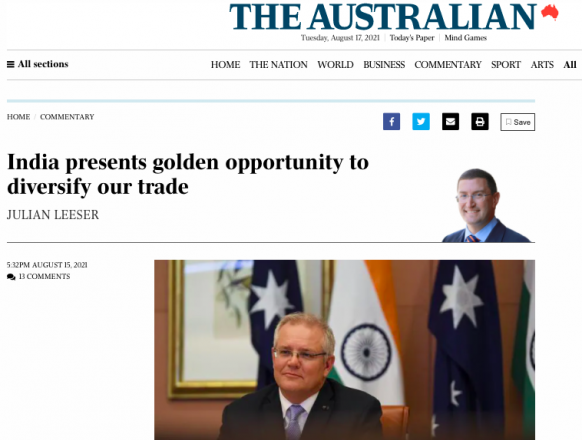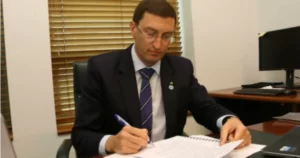On the occasion of India’s 75th Independence Day there is a great deal to celebrate. The ties between Australia and India predate India’s independence and Australia’s federation and go back to when trade commenced between India and the colony of New South Wales.
Indians volunteered and fought with the Australian Imperial Force in World War I, a fact commemorated by a cenotaph in my electorate. And the Australian and Indian forces fought together at Gallipoli. These ties, forged over a century ago, have grown and deepened.
In the midst of the pandemic, Prime Minister Scott Morrison met with Prime Minister Narendra Modi, in a historic summit, to upgrade our bilateral relationship to a Comprehensive Strategic Partnership. The Morrison-Modi agreement has seen increased cooperation in the sectors that matter most.
India is a digital superpower and Australia is a critical minerals superpower. Together we are working to shape the future of technology. India will soon have the world’s largest population of digitally connected people and the decisions India makes will determines if the future of the internet is one of openness and transparency or censorship and control.
Building secure and reliable supply chains for critical minerals is important to both countries. Neither India nor Australia wants to see geopolitics cause shortages in materials essential to things like smartphones. Australia agreed to expand resources partnerships and cooperate with India on new technologies for exploration and extraction of critical minerals.
Oceans policy is a new frontier for the relationship. We both have Indian Ocean coasts, and through initiatives like India’s Indo-Pacific Oceans Initiative and our Pacific Step-Up we are leading on scientific research and environmental protection for our oceans.
We continue to build trust and interoperability through defence engagement. In 2014 there were 11 joint defence activities. In 2019 there were 28. That growth culminated in the Indo-Pacific Endeavour travelling to India (the largest ever Australian deployment to India) for our bilateral defence exercises AUSINDEX; and last year’s invitation to participate in Exercise MALABAR.
India has now joined a very small group of countries with which we do submarine exercises – a sign of our very close cooperation and trust.
Earlier this month Defence Minister Peter Dutton said he hoped India would join the next Talisman Sabre defence exercises which would see both our defence forces jointly exercising with the US, Japan, and others.
Those same four countries share a special relationship through the Quad based on our mutual interest in a free, open, inclusive, rules-based international order in the Indo-Pacific.
But it’s not just on strategic issues where Australia and India converge. India’s economic modernisation presents great opportunities.
While we have disagreements on agriculture, and we were disappointed when India didn’t join the RCEP trade bloc, there are great opportunities for Australian businesses in India. As Prime Minister Modi said, “India has replaced red tape with red carpet”.
Just as Wipro, TCS and Tech Mahindra all have major Australian operations, ANZ, Linfox, Atlassian and many others have chosen India. Bengaluru is the new Silicone Valley.
India presents an opportunity for Australia to diversify our trade. We have set ambitious targets for India to be in our top three export markets and one of our top three destinations for investment in Asia in the next 15 years.
Trade Minister Dan Tehan’s ambition for a free trade agreement and the appointment of Tony Abbott as the government’s special envoy on India indicates a new seriousness around the trade relationship.
But the glue that holds our two nations together more than anything else is the people. Those people-to-people links bind us together more than shared interests in foreign policy or trade ever could.
Over the last 20 years, the number of Indians in Australia has grown from around 60,000 to more than 700,000. In the next decade the Indian-born community is projected to overtake the Chinese-born community as the largest migrant community in Australia, reaching 1.4 million people. Former DFAT Secretary Peter Varghese has suggested that in time the Indian diaspora would be as politically significant as the Irish diaspora has been.
Skilled migration is an important part of this picture. We want talented, driven Indians to continue to bring their technical expertise, entrepreneurship and aptitude for study and make Australia home; while more Australians are choosing to spend time living and working in India.
The Indian community shares Australia’s values because India itself shares our values. Indian Australians are making their mark in every field of endeavour: business, politics, sport and the arts. The Indian community plays a vital role in ensuring the relationship avoids getting lost in translation.
As the chair of Parliamentary Friends of India, I welcome and celebrate the unique contribution made by the Australian Indian community and look forward to further strengthening of our bilateral ties as India enters its 75th year.
Julian Leeser is the federal Member for Berowra.




